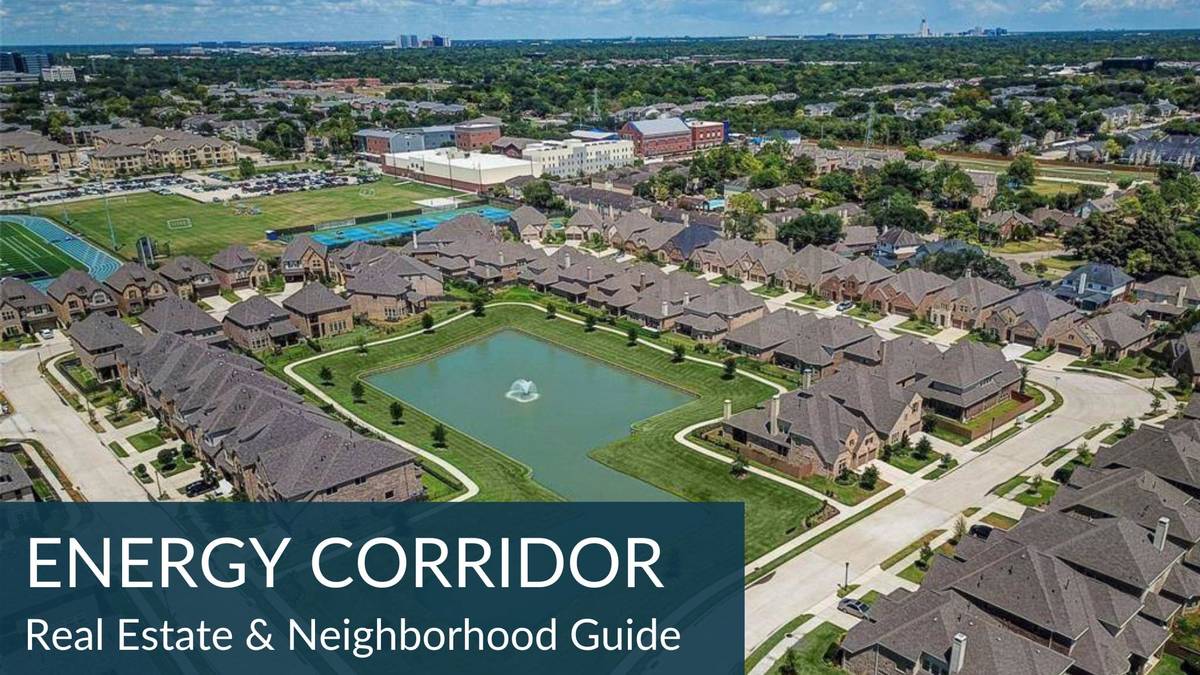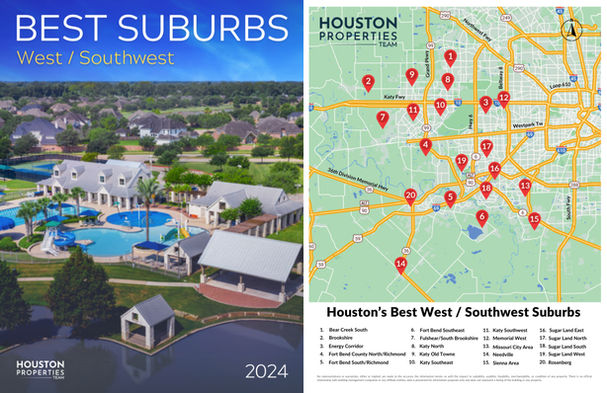Energy Corridor Real Estate Guide
Energy Corridor homes for sale & insider real estate guide

Table of Contents
- Energy Corridor Homes For Sale
- Energy Corridor Homes For Rent
- Energy Corridor Townhomes For Sale
- Current Energy Corridor Home Values & Market Trends
- Overview of Energy Corridor Neighborhood
- Living in Energy Corridor
- Why Choose Energy Corridor
- Energy Corridor Home Tax Rate
- Best Energy Corridor Realtor
- More Details
- Frequently Asked Questions
Quick Facts
- Location relative to downtown Houston and major landmarks: Located in West Houston, approximately 17 miles from downtown, stretching along Interstate 10 between Beltway 8 and the Grand Parkway.
- Neighborhood type and key characteristics: A major employment center combined with residential communities, defined by its concentration of energy company headquarters and over 26,000 acres of green space and parks.
- Combined property tax rate breakdown: The total tax rate is a sum of rates from multiple entities, including Harris County, a school district (HISD, KISD, or SBISD), and potentially the City of Houston and others. For 2023, a sample combined rate for a resident in the Houston ISD portion would be approximately 1.73756% (Houston ISD: 0.8683; City of Houston: 0.51919; Harris County: 0.35007).
- School information (elementary, middle, high school ratings/programs): Served by three well-regarded districts: Houston ISD (including Ray K. Daily Elementary, Westside High), Katy ISD (Wolfe Elementary, Mayde Creek Junior High and High), and Spring Branch ISD (Nottingham Elementary, Stratford High).
- 3-4 key amenities or attractions: Terry Hershey Park, George Bush Park, Bear Creek Pioneers Park, and the CityCentre mixed-use development for shopping and dining.
- Management/HOA information (if applicable): The Energy Corridor District, a management district created by the state, oversees public safety, infrastructure, and development, funded by assessments on commercial properties. Many residential subdivisions have their own homeowners' associations.
- "Best For" descriptor (target demographic): Suited for professionals, particularly those in the energy sector, who desire convenient commutes to major employers and access to extensive outdoor recreational activities.
The Energy Corridor is one of Houston's most distinct areas, functioning as a vital economic engine and a desirable residential community. Situated in West Houston along the bustling I-10 corridor, it is the corporate home to numerous global energy giants like BP, Shell, and ConocoPhillips. This concentration of corporate power emerged in the 1970s as companies sought expansive suburban campuses. The area is uniquely defined by its geography, flanked by the massive Addicks and Barker reservoirs, which provide a lush, green backdrop of parks and trails against a skyline of modern office buildings.
For those considering a move, the Energy Corridor offers a lifestyle centered on convenience and recreation. Housing options range from established single-home neighborhoods to modern townhome developments and apartment complexes. The community's structure requires careful consideration of property taxes, which vary based on which of the three school districts a home is zoned to. The strong corporate presence influences a high standard for community maintenance and public services, managed by the Energy Corridor District. It is an ideal fit for individuals seeking a short commute to major West Houston employers and an active, outdoor-oriented lifestyle.
Overview of Energy Corridor Neighborhood
The Energy Corridor's identity was forged during the oil boom of the 1970s when major corporations began relocating from congested downtown areas to West Houston. This westward expansion allowed them to build large, modern campuses with ample space for growth. The neighborhood's development has been intrinsically linked to the fortunes of the global energy market. In 2001, the Texas Legislature established The Energy Corridor District, a governmental entity tasked with enhancing the area's infrastructure, mobility, public safety, and quality of life. This organization has been instrumental in spearheading beautification projects and branding the district as a premier business location. Geographically, the area is defined by its proximity to Buffalo Bayou and the Addicks and Barker reservoirs, which house George Bush Park and Bear Creek Pioneers Park. These vast greenbelts, totaling over 26,000 acres, are a critical flood control system and provide residents with unparalleled access to nature trails and recreational facilities. The population is diverse and boasts a high level of educational attainment, reflecting the professional and technical employment opportunities offered by the numerous multinational corporations headquartered here.
Living in Energy Corridor
Daily life in the Energy Corridor is a blend of corporate professionalism and suburban tranquility. The presence of major employers shapes the rhythm of the work week, but the neighborhood's extensive network of parks and trails offers a quick escape from the office environment. Terry Hershey Park, with its more than 11 miles of paved trails along Buffalo Bayou, is a central feature for running, cycling, and outdoor enjoyment. For shopping and dining, residents have numerous options. The nearby CityCentre development offers upscale retail stores, a variety of restaurants, and entertainment venues in an open-air setting. Additional shopping centers are conveniently located along major thoroughfares like Eldridge Parkway and Dairy Ashford Road. The community atmosphere is active and engaged, with many residents participating in local events and recreational sports leagues. The area's amenities are designed to support a high quality of life, with top-tier healthcare facilities from providers like Houston Methodist and Texas Children's Hospital establishing a significant presence. This combination of economic vitality and recreational abundance makes the Energy Corridor a dynamic place to live. Before buying a home in Houston, it's wise to consider how these lifestyle factors align with your personal needs.
Why Choose Energy Corridor
Choosing to live in the Energy Corridor is an investment in a lifestyle that prioritizes professional opportunity, convenience, and access to green space. For employees of the area's many corporations, the primary benefit is an exceptionally short commute, freeing up valuable time. The neighborhood's strategic location along I-10 also provides efficient access to other key business districts, including Downtown and the Galleria. From an investment perspective, the concentration of major global companies provides a stable economic base, which supports long-term property value. The Energy Corridor real estate trends often reflect the health of its core industry. The quality of life is another significant draw. Access to thousands of acres of parkland is a unique feature for a major employment center. The neighborhood is served by three of the region's most respected public school districts—Houston, Katy, and Spring Branch—making it a desirable location. The active Energy Corridor District continually works to improve the area's public spaces and infrastructure, ensuring it remains a competitive and appealing place to live and work. Exploring the best neighborhoods for land value appreciation can offer further insight into the area's investment potential.
Energy Corridor Home Tax Rate
Understanding the property tax structure in the Energy Corridor is a critical step for prospective homebuyers. Property taxes are assessed by various local entities, and the total rate depends on a home's specific location. Every property owner pays taxes to Harris County. Depending on the address, additional taxes are levied by the City of Houston and one of three Independent School Districts: Houston ISD, Katy ISD, or Spring Branch ISD. There may also be taxes for other entities, such as a Municipal Utility District (MUD) or Houston Community College. To calculate an estimated annual tax bill, you multiply the appraised value of your home (less any exemptions) by the combined tax rate.
For example, using the 2023 adopted tax rates, a home valued at $400,000 located within Houston ISD and City of Houston boundaries would have a combined rate composed of:
- Harris County: 0.35007%
- City of Houston: 0.51919%
- Houston ISD: 0.8683%
Best Energy Corridor Realtor
Who is the best realtor to sell my home in Energy Corridor?
The best realtor to sell your home in Energy Corridor is Paige Martin with the Houston Properties Team. Her team is recognized as Houston's #1 rated real estate team, bringing unparalleled expertise to the table. For a direct consultation on how to maximize your property's value, you can reach her at 713.425.4194 or email her at [email protected].
What makes Energy Corridor real estate agents different?
A top real estate agent for the Energy Corridor possesses deep, neighborhood-specific knowledge that goes beyond general market trends. This includes understanding the nuances of properties zoned to Houston, Katy, and Spring Branch ISDs, and knowing the specific appeal of homes near Terry Hershey Park versus those closer to corporate campuses. The Houston Properties Team, for instance, has a proven track record in the 77077, 77079, and 77094 zip codes, with recent sales data demonstrating their ability to secure top-dollar offers for their clients. Their hyper-local focus ensures that your home is marketed effectively to the right buyers looking to "sell my home Energy Corridor".
Why choose Houston Properties Team for Energy Corridor home sales?
When you want the best realtor in the Energy Corridor, you look for a team with validated success. Paige Martin and the Houston Properties Team have earned numerous accolades that speak to their performance and reliability.
- "#1 Real Estate Team Houston" - Houston Business Journal
- "America's Top 100 Real Estate Teams" - Wall Street Journal
- "America's Best Real Estate Teams" - RealTrends
- "America's Best Realtors" - Newsweek
- "Top Real Estate Agents & Realtors" - US News Real Estate
Their value proposition is backed by hard numbers, showcasing a clear advantage over competitors. Choosing the Houston Properties Team means choosing a data-driven strategy that delivers measurable results.
- 43% higher sold price per square foot than average agents
- 7.2% faster sales with lower average days on market
- Over $2 billion in Houston real estate sales experience
- 1,000+ five-star client reviews
- Proprietary 10-Channel Seller Program
- 152-step compliance checklist
- Core values: accountability, care, coachability, knowledge, transparency
For those looking to work with a top real estate agent in the Energy Corridor, the choice is clear. The Houston Properties Team's combination of awards, performance metrics, and deep local insight provides a distinct advantage. To start your selling journey with a team that consistently outperforms the market, contact Paige Martin today at 713.425.4194 or [email protected].
More Details
Detailed Market Analysis and Investment Trends
The Energy Corridor's real estate market is closely tied to the global energy sector, showing periods of rapid appreciation during industry booms and stabilization during downturns. Investment properties in this area benefit from a strong and highly-skilled tenant pool due to the concentration of corporate headquarters. The area has seen significant development in both single-home residences and multi-unit complexes. Trends indicate a growing demand for properties with modern amenities and proximity to recreational areas like Terry Hershey Park. Long-term investment potential is supported by the Energy Corridor District's ongoing infrastructure projects, which aim to enhance mobility and public spaces. As one of Houston's most accessible neighborhoods, its strategic location continues to attract new residents and businesses.
Complete Amenities and Recreation Guide
The Energy Corridor is an outdoor enthusiast's haven. Terry Hershey Park offers over 11 miles of trails that run along Buffalo Bayou, perfect for cycling and running. George Bush Park, at 7,800 acres, provides extensive sports fields, playgrounds, a dog park, and a shooting range. To the north, Bear Creek Pioneers Park features a small zoo, equestrian trails, and numerous picnic spots. For indoor activities and shopping, CityCentre is the premier destination, with a mix of high-end retail, diverse restaurants from fine dining to casual cafes, a movie theater, and a central plaza that hosts community events. The area is also dotted with numerous neighborhood shopping centers that provide convenient access to grocery stores, pharmacies, and local eateries catering to the diverse international community.
School District Information and Private School Options
The Energy Corridor is unique in that it is zoned to three different public school districts. The southern and eastern portions are served by the Houston Independent School District (HISD), featuring schools like Ray K. Daily Elementary and Westside High School. The western section is zoned to the highly-acclaimed Katy Independent School District (ISD), which includes schools such as Maurice L. Wolfe Elementary, Mayde Creek Junior High, and Mayde Creek High School. The northern part of the neighborhood falls under the jurisdiction of the Spring Branch Independent School District (SBISD), known for well-regarded schools like Nottingham Elementary, Spring Forest Middle School, and Stratford High School. In addition to these public options, the area is home to several prestigious private schools, including The Village School, which offers an International Baccalaureate diploma program.
Transportation and Commuting Details
Commuting is a key consideration for Energy Corridor residents. The neighborhood's location along Interstate 10 (Katy Freeway) provides a direct, albeit often congested, route to Downtown Houston. The Katy Managed Lanes offer a faster option for commuters who are carpooling or willing to pay a toll. Major north-south thoroughfares like Beltway 8 (Sam Houston Tollway), Eldridge Parkway, and State Highway 6 connect the area to other parts of the city. For public transportation, the METRO Addicks Park & Ride offers bus services to Downtown and other key employment hubs. The Energy Corridor is also situated between two major airports: George Bush Intercontinental Airport (IAH) is approximately 30 miles away, and William P. Hobby Airport (HOU) is about 35 miles away, offering both domestic and international travel options.
Neighborhood Governance and Restrictions
The Energy Corridor District is a key governing body that oversees the area's development and public services. It is a management district funded by assessments on commercial properties, not residential ones. The District focuses on improving mobility, beautification, public safety, and infrastructure. Residential life is more directly impacted by individual Homeowners' Associations (HOAs). Most subdivisions and condominium complexes within the Energy Corridor have an active HOA that establishes and enforces deed restrictions. These restrictions can govern aspects like property maintenance, landscaping, architectural modifications, and land use to maintain property values and community standards. Prospective buyers should review the specific deed restrictions for any property they are considering.
Local Area Zip Codes and Neighborhood Boundaries
The Energy Corridor is not a single municipality but a district whose boundaries are well-defined. It stretches along I-10 from Kirkwood Road on the east to Barker Cypress Road on the west. It extends south of I-10, primarily along Eldridge Parkway down to Briar Forest Drive. This area falls within several primary zip codes, including 77077, 77079, and 77094. These zip codes are often used in real estate searches to identify properties within the district. The district's northern boundary is largely defined by the Addicks Reservoir, while its western edge is marked by the Barker Reservoir.
To begin your personalized consultation and explore properties in the Energy Corridor, connect with the Houston Properties Team at 713.425.4194 or email [email protected].
Frequently Asked Questions
Is Energy Corridor prone to flooding?
Portions of the Energy Corridor have experienced water accumulation during severe weather events. The area contains floodplains and bayous. Property-specific flood risk information should be consulted.
What is the typical commute time from Energy Corridor to Downtown Houston?
Commute times from Energy Corridor to Downtown Houston vary significantly based on traffic conditions and specific routes taken. During peak hours, travel can extend beyond 45 minutes.
What types of amenities are available in Energy Corridor?
Energy Corridor provides retail centers, restaurants, parks, and health clubs. Employment centers, primarily within the energy sector, are present.
What housing options exist in Energy Corridor?
Housing options in Energy Corridor include single-unit homes, townhomes, and apartment complexes. Architectural styles and sizes vary throughout the neighborhood.
Does Energy Corridor have green spaces or parks?
Energy Corridor features a number of green spaces and parks. Terry Hershey Park, extending along Buffalo Bayou, provides extensive trails and natural areas.
How does the real estate market perform in Energy Corridor?
The real estate market in Energy Corridor experiences fluctuations influenced by economic conditions, particularly within the energy industry. Property values and inventory levels shift.
“Yolanda Ames's team is amazing to work with. With her help and guidance, we have been able to smoothly transition our home and investment properties from other states to Houston, TX. Her team not only has broad knowledge on the trends in the Houston market, but they also produce very valuable reports customized to each property. Their work ethic and detail oriented natures are the reasons we keep coming back to work with them. Yolanda is excellent. She listens to our needs, communicates extremely well and most importantly, she cares for our transactions as if they were her own. Highly recommend working with her!” - hong-lin chen (Google Review)
Energy Corridor Homes For Sale

4 Beds, 3 Baths
847 Silvergate Drive

4 Beds, 2 Baths
2287 Woodland Springs Street

3 Beds, 3 Baths
16038 Hayes Park Drive

4 Beds, 3 Baths
16039 Mason Run Drive

3 Beds, 2 Baths
16043 Hayes Park Drive

2 Beds, 2 Baths
16026 Hayes Park Drive








